How To Install Yum On Centos
The red Hat package manager, commonly known as RPM, is a package direction organisation used to manage, install, uninstall, upgrade, listing, and check .rpm-based packages in Redhat-based Linux distributions.
The files with the extension .rpm in Linux are similar the culling of .exe files in Windows. The .rpm files are used to install applications in any RedHat-based Linux Operating system. It is a packaging format that is helpful when installing tertiary-party software on an operating system. In this post, we will talk over the process of installing an RPM parcel on CentOS 8.
There are three methods we can use to install an RPM package on CentOS 8:
- By using DNF
- By using Yum
- Past using RPM
Permit'south begin with the first method and learn to install an RPM package using the DNF package director.
Installing RPM packages by using DNF
DNF has replaced Yum as the latest version of it in CentOS 8.
Handling dependencies is an important task when installing a package on a Linux-based operating arrangement. Therefore, DNF should always be preferred over other bundle managers when installing an RPM package every bit it is really proficient at handling dependencies.
To install an RPM bundle with DNF, merely provide the RPM package to the "dnf install" command:
$ sudo dnf install ./packet.rpm
For example, nosotros desire to install the latest version of squad viewer on the CentOS 8 Operating system. To install the latest version of TeamViewer, visit the download page of TeamViewer:
https://www.teamviewer.com/en/download/linux/
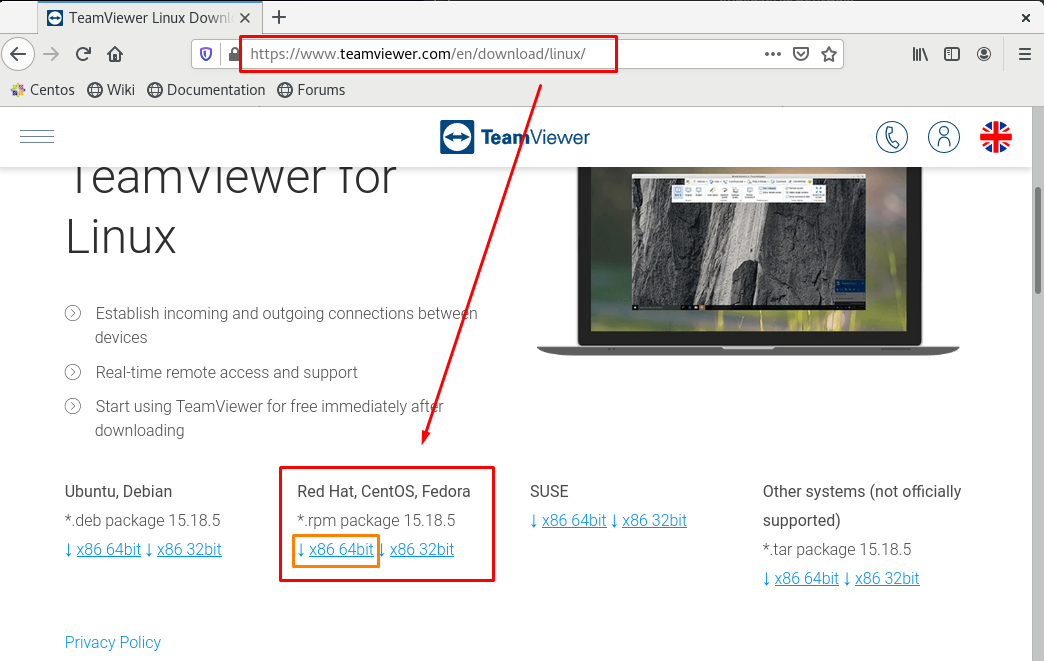
Once you are on the download page of the Teamviewer application, Click on the Highlighted link in the to a higher place screenshot.
A pop-up box volition announced to download the RPM file for installing TeamViewer on CentOS 8:
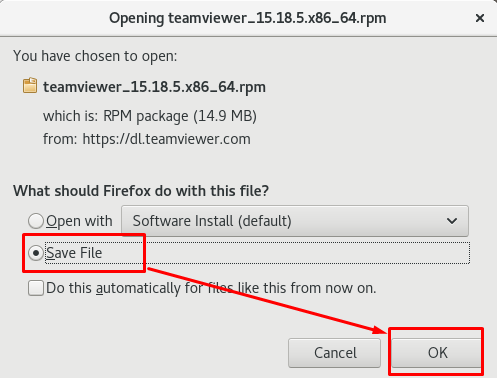
Click on the relieve file pick and click "OK" to start the downloading process of the TeamViewer RPM file.

In one case the RPM package of TeamViewer is downloaded, switch back to the final and navigate to the "Downloads" directory where the RPM package is downloaded using the "cd" control:
![]()
Once yous are in the Downloads directory, execute the "ls" control to confirm the presence of the TeamViewer RPM file:

At present to install the latest version of TeamViewer on CentOS viii, simply provide the download RPM file of TeamViewer to the "dnf install" command every bit shown below:
$ sudo dnf install ./teamviewer_15.18.5.x86_64.rpm
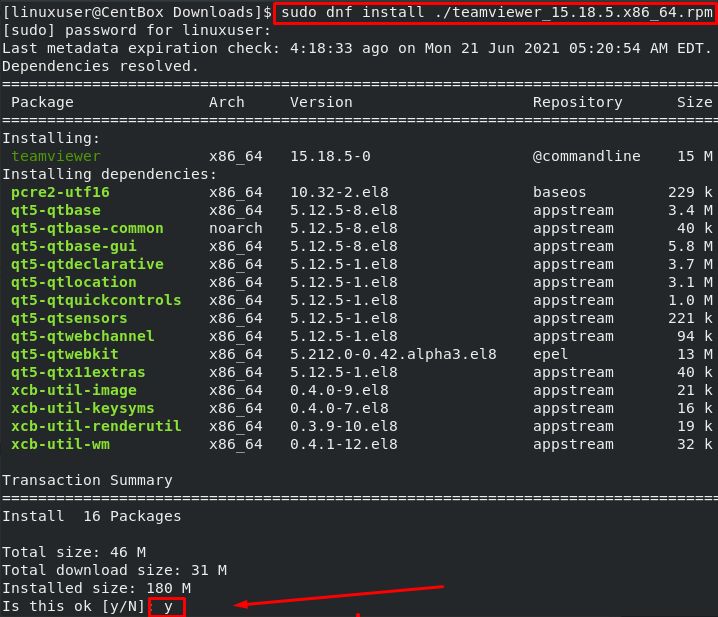
Information technology will enquire to install some boosted dependencies and accept boosted disk space, so blazon "y" and striking "Enter" to continue; the installation volition start and consummate in a matter of seconds.

As yous can encounter in the screenshot to a higher place, the latest version of TeamViewer is successfully installed using an RPM package on CentOS 8 Operating organization.
Install an RPM package from the web
You can also download and install an RPM package located on the web using DNF. To install the RPM package, just requite the direct web accost of the RPM package to the DNF.
For instance, if we want to install epel-release directly from the fedoraproject.org, the command would go like this:
$ sudo dnf install https://dl.fedoraproject.org/pub/epel/epel-release-latest-viii.noarch.rpm
DNF will automatically look for dependencies, and it volition enquire you for confirmation before installing the bundle and its dependencies.
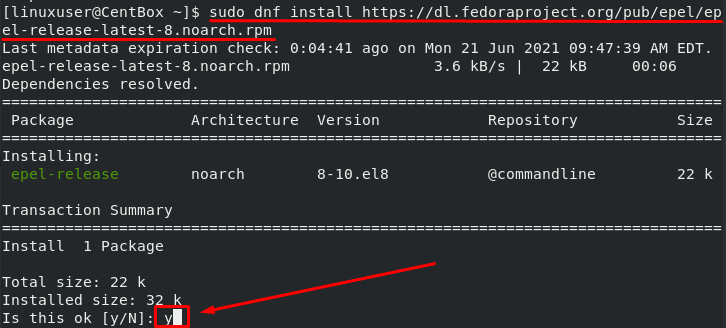
Input "y" and press Enter to initiate the installation procedure of epel-release along with its dependencies.

DNF likewise lets you know whether the bundle is compatible with your operating organisation. If a packet is not uniform with your CentOS Operating organization, then either update the Operating system or endeavor some other bundle that is compatible with the Operating system.
Installing RPM packages using YUM
As mentioned above, the YUM package management system has been replaced with DNF in the latest version of CentOS, just you can continue using it.
The syntax in this method is the aforementioned equally the DNF method. Only supercede DNF with YUM.
For example, to install a bundle using the YUM package managing director, the syntax of the yum control would expect similar this:
$ sudo yum install ./path/packet.rpm
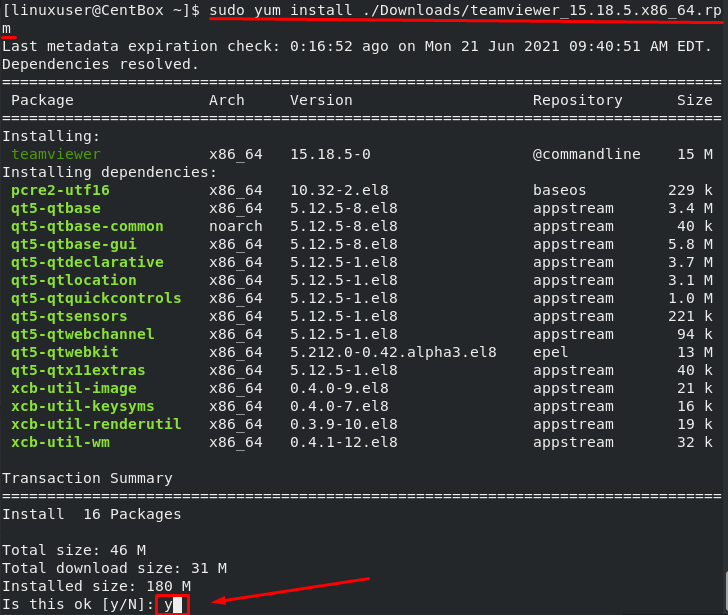
Later on executing the above command, the package, as well as its dependencies, will be installed.
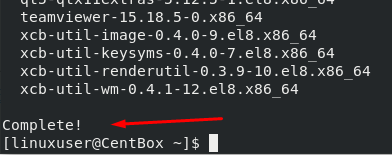
Installing RPM packages using RPM
This is a conventional and standard method to install RPM packages on CentOS 8 Operating arrangement, but you should e'er prefer using DNF over it if you don't want things to get messy.
Using this method to install RPM packages has its limitations as RPM does not handle dependencies, and you have to look for them manually.
To install a package with rpm control, apply the "-i" flag and provide information technology an RPM package installer file:
$ sudo rpm -i ./path/package.rpm
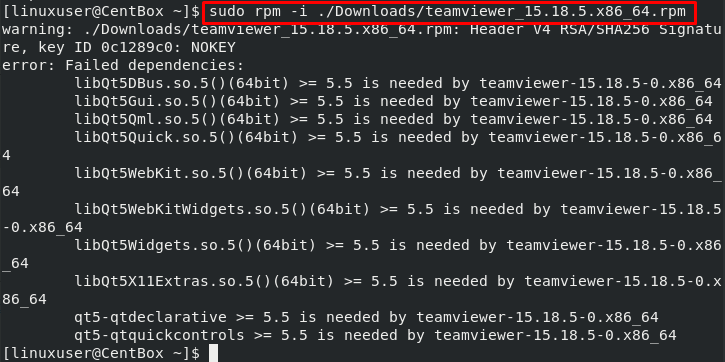
Equally y'all tin can witness in the screenshot above, the dependencies are non installed, so the RPM package can't exist installed. So instead, you accept to install dependencies manually first; then, you can install TeamViewer using the "rpm" control.
Decision
External RPM installs should be limited as much as possible as they can brand your system unstable. Nonetheless, if you want to install the latest version of whatsoever application, you must use the latest RPM file.
In this article, we have learned the installation process of RPM-based packages using iii unlike methods. Nosotros also discussed why DNF should always exist preferred over other methods every bit it handles dependency issues. Information technology might go necessary to use the RPM utility in rare cases, only DNF will always be the best bet.
Source: https://linuxhint.com/centos_how_install_rpm/
Posted by: millerbeemed94.blogspot.com


0 Response to "How To Install Yum On Centos"
Post a Comment